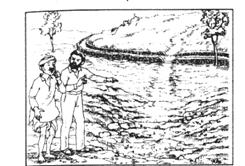/regions/india
India
Water supply and sanitation - Assessment - A WHO-UNICEF sponsored study (2002)
Posted on 17 Sep, 2009 11:07 AMThis report includes the findings of a study by the Planning Commission sponsored by the World Health Organisation and The United Nations Children's Fund (UNICEF) that conducted an assessment of the water and sanitation situation in India in 2002. The assessment revealed that:
Rural water supply - Planning Commission
Posted on 17 Sep, 2009 10:58 AMThis article on the Planning Commission site presents a review of the government figures regarding coverage of all rural habitations in the country with good drinking water supply.
How to measure water percolation rate
Posted on 15 Sep, 2009 04:53 PMTo measure how fast water percolates into the soil, you need to measure the time it takes for a specific amount of water to soak into a specific area of soil. The easiest way to do this is to get a length of cylindrical pipe that is sharp enough to push (or hammer) into the soil at one end. Mark it with two lines – one is the line to which you insert it into the soil, and the other is the line to which you fill the water.
How to measure slope and mark contours
Posted on 15 Sep, 2009 04:43 PMYou can measure slope by making use of gravity. Find a protractor for measuring angles. Attach a straw across the straight edge of the protractor.
How to create a farm pond for water storage
Posted on 15 Sep, 2009 03:56 PMThe ideal farm pond should be dug into the ground in a naturally low-lying area. Some of the soil that is removed can be used to construct an earthen berm around the pond, which should be planted with trees and grasses for stability. The shade and wind protection provided by the raised mound and vegetation will reduce evaporative losses.
Groundwater recharge structures
Posted on 15 Sep, 2009 03:41 PM Where conditions are favorable, it is better to recharge the groundwater than to create surface ponds for storage. This approach minimizes evaporative losses, and often improves water quality. Recharge structures can be anything from a small pit simply dug into the soil, to a borewell converted for recharge. Recharge structures are useful in sloping landscapes where the water would not otherwise have time to sink into the ground before running off.
Where conditions are favorable, it is better to recharge the groundwater than to create surface ponds for storage. This approach minimizes evaporative losses, and often improves water quality. Recharge structures can be anything from a small pit simply dug into the soil, to a borewell converted for recharge. Recharge structures are useful in sloping landscapes where the water would not otherwise have time to sink into the ground before running off.
The how and why of tank restoration
Posted on 15 Sep, 2009 02:19 PMWhere possible, it is much more cost effective to restore existing tanks, than to build new tanks. Restoration can involve silt removal to increase the storage capacity of the tank and reduce evaporative loss. The silt can be used to restore the earthen bund, and any remaining silt can be applied to nearby farmland. The outflow structure can also be improved.
Tank Development - Design and features
Posted on 15 Sep, 2009 02:11 PMIf the intention is to develop a tank by holding back a large amount of water, then the dam must be carefully designed (with the assistance of experienced local people or engineers).
How to create check dams for water conservation
Posted on 15 Sep, 2009 01:07 PMIn addition to controlling gully erosion, check dams also serve to slow the movement of water, allowing increased percolation into the soil. Just above a check dam is a good place to put in a percolation structure. Silt that builds up behind the dam creates good farmland, which can be planted after the rains while it retains moisture. The following series of pictures show one farmer’s success with building a percolation tank just upstream of a series of check-dams.
How to control gully erosion
Posted on 15 Sep, 2009 12:58 PM Over the years, unchecked soil erosion can lead to the formation of deeper and deeper gullies. There are several methods for controlling gully erosion, which can be chosen depending on the materials available.
Over the years, unchecked soil erosion can lead to the formation of deeper and deeper gullies. There are several methods for controlling gully erosion, which can be chosen depending on the materials available.
If it is a small gully, vegetation can be planted in strips across the gully to slow the velocity of water, trap silt, and prevent further erosion.